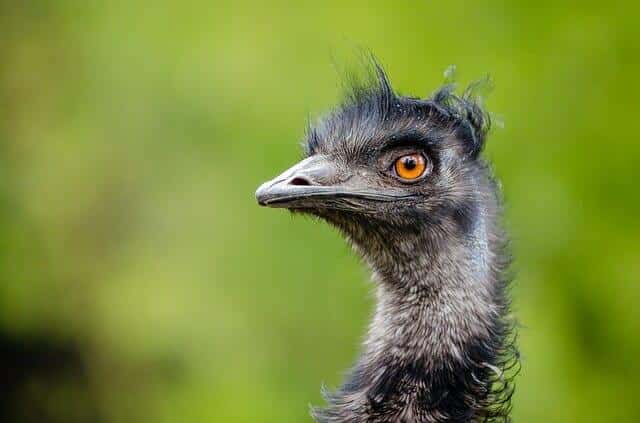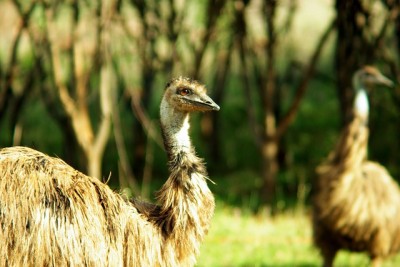You’ve tried raising chickens on your own land and enjoyed spending afternoons watching their antics in your yard, but now it’s time for something new. Provided you have a large yard and a taste for adventure, why not give emus a try? Raising emus on your homestead can be a great investment, as just about every part of it is useful and valuable at harvest time.
Housing
Emus are capable of reaching high speeds and need ample space to run. It’s recommended to keep them in a long and narrow enclosure, no smaller than 120-feet long and 18-feet wide for a pair of adults to maximize their running space. On a larger scale, as many as 50 adults can be kept per acre. Fencing should be at least six-feet tall, and have relatively small holes such as chain link or two-inch by four-inch woven wire.
Though they’re relatively hardy, they do need a shelter to get out of the elements and a few inches of bedding such as shavings of straw for bedding. For the coldest climates, a full enclosure or barn is recommended, but a three-sided shelter is sufficient in most places.
Handling
Emus are very friendly and docile if hand-raised from hatching, but if allowed to reproduce and raise their own young naturally, the resulting chicks imprint on their emu parents rather than their human caregivers and take up wild habits, making them nearly impossible to handle and potentially aggressive.
Given their intimidating size and the requirement for a long and narrow enclosure, they could potentially make a good guard animal if you were willing to surround your property with a fence.
Feeding
Emus have very specific feed requirements, and should be given a specialized feed to ensure they’re getting the proper nutrition. Since they lack a croup like other birds, and have a very quick digestive system, they need high-nutrient food to meet their daily requirements. In the wild they eat high-nutrient fruit and seeds, which helps them develop the valuable back fat for emu oil.
“The Big Book Of Off The Grid Secrets” — Every Homesteader Needs A Copy!
An adult needs between one to one and a half pounds of feed per day, while growing adolescents need higher protein feed and two or more pounds per day. Specialized emu food can cost as much as twice the price of chicken feed, and you’ll need to secure a reliable source of feed.
Emu Products
Emus are often referred to as the most useful bird, because so many different products are made from their bodies. A single emu produces usable meat, oil, leather, feathers, claws, bones and eggs.
Emu Meat
Emus have lean red meat that cooks well into burgers and steaks, and can fetch as much as $20 per pound in some specialty stores. It cooks quickly and readily absorbs flavor from a variety of marinades. If you’d like to try emu meat before committing to raising one, try a tender, top loin steak marinated and then grilled to medium rare for the tastiest emu sample.
The average emu, harvested at 16 months of age, produces just 26 pounds of usable meat. They’re relatively expensive to process commercially, meaning that profit margins would be quite low or non-existent if they were only useful for their meat. Fortunately, while the meat sales only pay for raising and processing costs, there are many other valuable parts of an emu.
Emu Oil
The main reason emus are raised is for their oil, which is used in cosmetics and skin care products, and can sell for as much as $150 per quart. A single emu can produce as much as five quarts of emu oil. Emu oil is made by refining the back fat harvested from the bird during slaughter. Emu use this fat to incubate them from cold weather and as a reserve against hard times when food is scarce.
Emu Leather
Beyond meat and oil, emu skin is tanned into a high-value leather that’s used to make wallets, purses and boots. Due to the uniqueness of the leather, products made from tanned emu fetch premium prices, especially in overseas markets.
Emu Feathers, Eggs and Bones
Emu feathers are unique in that they produce two feathers from a single quill, meaning each feather is like two feathers attached at a single point on the emu’s body. This makes them desirable for craft products, fishing lures and high fashion.
Emu bones are also used for craft and science projects due to their light weight and large size. Whole skeletons sell for as much as $150. Decorated emu eggs and preserved emu claws are also commonly sold for their novelty value.
Do you have experience with emus? Share your advice on raising emus in the section below:
 Off The Grid News Better Ideas For Off The Grid Living
Off The Grid News Better Ideas For Off The Grid Living





